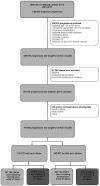Intrapartum interventions and outcomes for women and children following induction of labour at term in uncomplicated pregnancies: a 16-year population-based linked data study
- PMID: 34059509
- PMCID: PMC8169493
- DOI: 10.1136/bmjopen-2020-047040
Intrapartum interventions and outcomes for women and children following induction of labour at term in uncomplicated pregnancies: a 16-year population-based linked data study
Abstract
Objectives: We compared intrapartum interventions and outcomes for mothers, neonates and children up to 16 years, for induction of labour (IOL) versus spontaneous labour onset in uncomplicated term pregnancies with live births.
Design: We used population linked data from New South Wales, Australia (2001-2016) for healthy women giving birth at 37+0 to 41+6 weeks. Descriptive statistics and logistic regression were performed for intrapartum interventions, postnatal maternal and neonatal outcomes, and long-term child outcomes adjusted for maternal age, country of birth, socioeconomic status, parity and gestational age.
Results: Of 474 652 included births, 69 397 (15%) had an IOL for non-medical reasons. Primiparous women with IOL versus spontaneous onset differed significantly for: spontaneous vaginal birth (42.7% vs 62.3%), instrumental birth (28.0% vs 23.9%%), intrapartum caesarean section (29.3% vs 13.8%), epidural (71.0% vs 41.3%), episiotomy (41.2% vs 30.5%) and postpartum haemorrhage (2.4% vs 1.5%). There was a similar trend in outcomes for multiparous women, except for caesarean section which was lower (5.3% vs 6.2%). For both groups, third and fourth degree perineal tears were lower overall in the IOL group: primiparous women (4.2% vs 4.9%), multiparous women (0.7% vs 1.2%), though overall vaginal repair was higher (89.3% vs 84.3%). Following induction, incidences of neonatal birth trauma, resuscitation and respiratory disorders were higher, as were admissions to hospital for infections (ear, nose, throat, respiratory and sepsis) up to 16 years. There was no difference in hospitalisation for asthma or eczema, or for neonatal death (0.06% vs 0.08%), or in total deaths up to 16 years.
Conclusion: IOL for non-medical reasons was associated with higher birth interventions, particularly in primiparous women, and more adverse maternal, neonatal and child outcomes for most variables assessed. The size of effect varied by parity and gestational age, making these important considerations when informing women about the risks and benefits of IOL.
Keywords: epidemiology; maternal medicine; neonatology; obstetrics.
© Author(s) (or their employer(s)) 2021. Re-use permitted under CC BY-NC. No commercial re-use. See rights and permissions. Published by BMJ.
Conflict of interest statement
Competing interests: None declared.
Figures
References
-
- AIHW . Australian mothers and babies 2016 -in brief. Canberra: Australian Institute of Health and Welfare, 2018.
-
- NHS Digital . Maternity statistics 2016-17, 2017. Available: https://digitalnhsuk/catalogue/PUB30137
-
- AIHW . Australian mothers and babies 2018. perinatal statistics series no 35 cat no per 100. Canberra: AIHW, 2020.
MeSH terms
LinkOut - more resources
Full Text Sources
Medical


